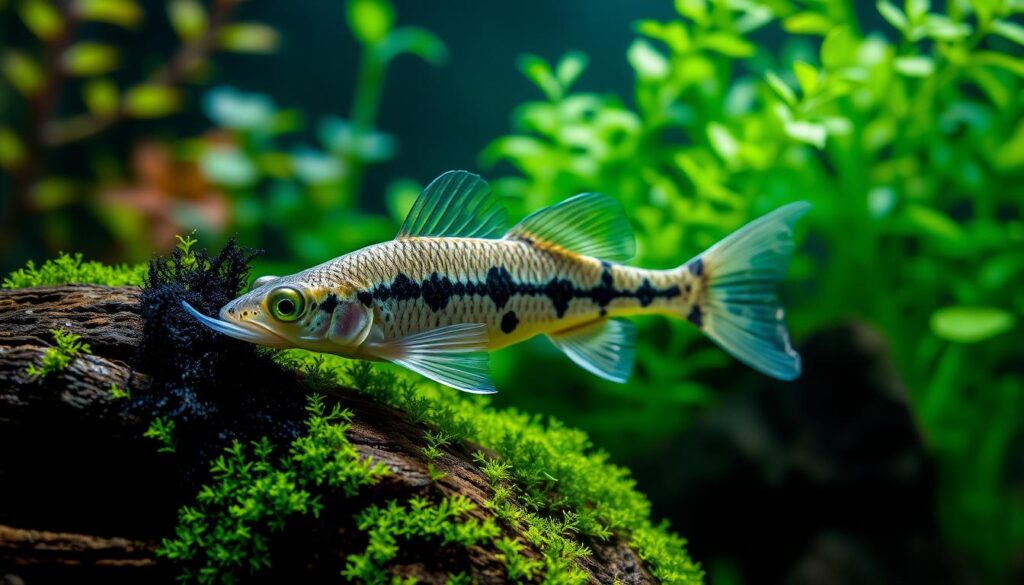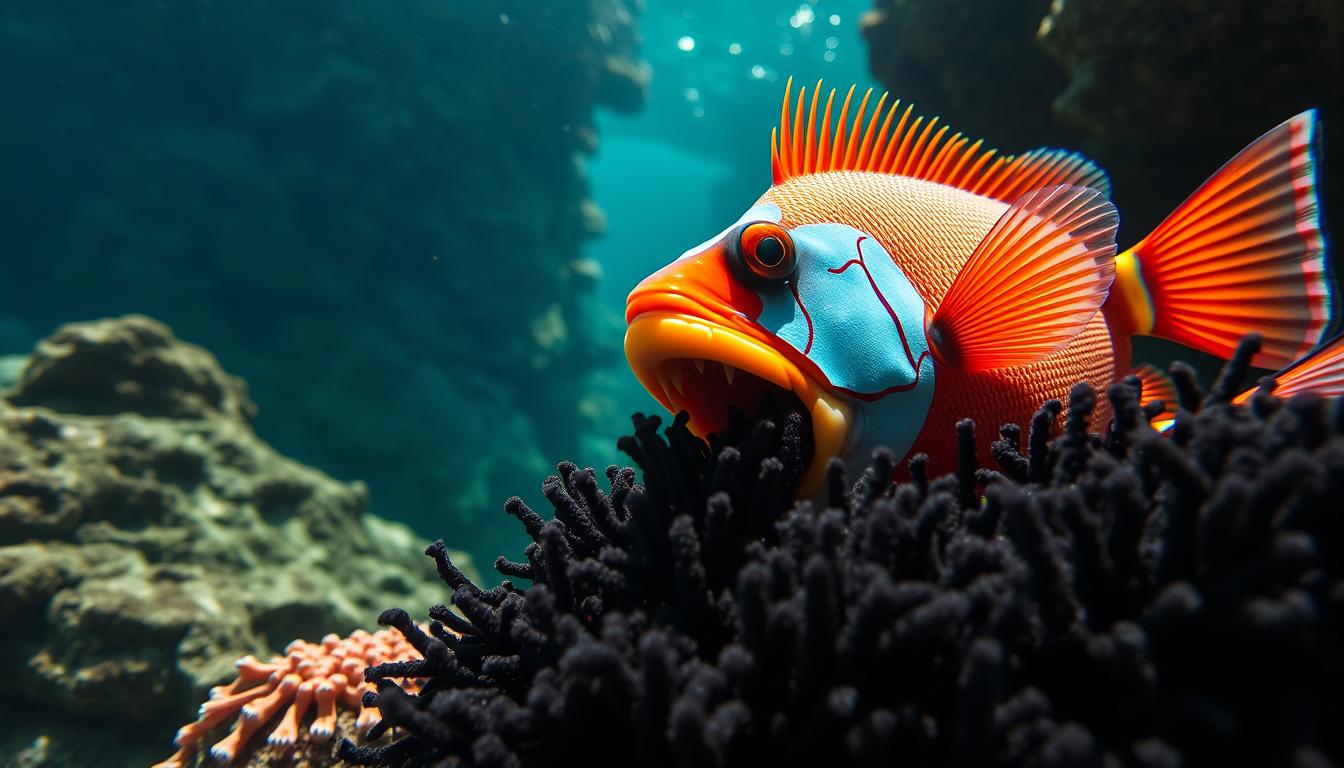Struggling with stubborn black beard algae in your aquarium? You’re not alone! In today’s video, we’re diving into the truth about fish that eat black beard algae — do they really help, or is it just hype? Stay tuned to find out which fish actually make a difference and which ones are just along for the swim!
Black beard algae can be a significant nuisance, but introducing certain algae-eating fish can effectively manage its growth. These fish species are not only beneficial for controlling algae but also add diversity to the aquarium.
Using the right fish can make a significant difference in maintaining a balanced aquarium ecosystem.
Key Takeaways
- Black beard algae can quickly overrun an aquarium.
- Algae-eating fish help control black beard algae growth.
- Introducing the right fish species maintains a balanced ecosystem.
- Certain fish are beneficial for both algae control and aquarium diversity.
- Effective algae management is crucial for aquarium health.
The Growing Problem of Black Beard Algae in Home Aquariums
Black beard algae, a scourge to many aquarium enthusiasts, continues to plague home aquariums despite best efforts to eradicate it. This persistent issue not only affects the aesthetic appeal of the tank but also indicates underlying water quality problems. As I delve into the world of aquarium maintenance, it becomes clear that understanding the root causes of black beard algae growth is crucial for effective control.
The presence of black beard algae is often a sign of an imbalance in the aquarium’s ecosystem. Factors such as high nitrate levels, soft water, and excessive lighting create an environment conducive to its growth. By addressing these factors, aquarium owners can take the first step towards mitigating the problem.
What Makes Black Beard Algae So Persistent
Black beard algae thrive in challenging conditions, making them a formidable foe for aquarium owners. Their ability to adhere to surfaces and resist common algae-control measures makes them particularly resilient. Understanding the characteristics that contribute to their persistence is key to developing effective control strategies.
| Characteristic | Description | Impact on Persistence |
|---|---|---|
| Adhesion Ability | Black beard algae can strongly adhere to surfaces. | Makes removal difficult. |
| Resistance to Control Measures | Resistant to many common algae control methods. | Requires specialized control strategies. |
| Growth in Challenging Conditions | Thrives in high nitrate, soft water, and high-light environments. | Persists despite unfavorable conditions. |
Common Causes of Black Beard Algae Outbreaks
Several factors contribute to the outbreak of black beard algae in home aquariums. Poor water quality and excessive lighting are among the most common causes. By identifying and addressing these underlying issues, aquarium owners can prevent the proliferation of black beard algae.
Regular water changes, proper lighting adjustments, and maintaining optimal water parameters are crucial steps in preventing black beard algae outbreaks. Additionally, introducing black beard algae eaters can help control their growth.
Boost your marine fish’s health naturally with Brightwell Aquatics Fish Recover M!
A botanical remedy that helps treat common issues safely.
👉 Click here to check it out now!
Fish That Eat Black Beard Algae: Recent Discoveries
Studies have revealed that specific fish species play a crucial role in controlling the growth of black beard algae. This stubborn algae can be a significant nuisance in home aquariums, but certain fish have been found to be effective in managing its growth.
How Certain Fish Species Target This Stubborn Algae
Some fish species have evolved to feed on black beard algae, utilizing specialized feeding behaviors. For instance, Siamese Algae Eaters are known to graze on this algae, helping to keep its growth in check. These fish have a particular appetite for black beard algae, making them valuable additions to aquariums plagued by this issue.
Latest Research on Algae-Eating Behavior
Recent studies have focused on understanding the algae-eating behavior of various fish species. Research has shown that certain species, such as the Amano Shrimp, are not only effective at consuming black beard algae but also exhibit behaviors that help prevent its regrowth. Understanding these behaviors can help aquarium owners create a more balanced ecosystem.
By leveraging the natural feeding behaviors of these fish, aquarium owners can develop effective strategies for managing black beard algae. This approach not only reduces the need for chemical treatments but also promotes a healthier aquarium environment.
Siamese Algae Eaters: The Premier Black Beard Algae Destroyers
When it comes to tackling black beard algae, Siamese Algae Eaters stand out as one of the most effective solutions for aquarium owners. These fish are renowned for their voracious appetite for algae, making them a valuable addition to any tank plagued by this persistent problem.
Identifying True Siamese Algae Eaters
To ensure you’re getting the real deal, it’s crucial to know how to identify true Siamese Algae Eaters. This involves looking out for specific physical characteristics and being aware of common lookalikes.
Physical Characteristics to Look For
True Siamese Algae Eaters have distinct features, including a slender body and horizontal stripes that run along their length. They are generally peaceful and can grow up to 6 inches in length.
Common Lookalikes to Avoid
Some fish are often mistaken for Siamese Algae Eaters, such as the Chinese Algae Eater, which, while similar, has different care requirements and may not be as effective against black beard algae.
Optimal Tank Conditions for Siamese Algae Eaters
To keep Siamese Algae Eaters thriving, it’s essential to replicate their natural habitat. This includes maintaining clean, well-oxygenated water and providing ample hiding places among plants or decorations. A temperature range of 72-82°F (22-28°C) is ideal.
Feeding Habits and Compatibility
Siamese Algae Eaters are primarily herbivores and will feed on algae, including black beard algae. They are peaceful and compatible with most community fish, making them a great addition to a community tank. However, they should be well-fed to prevent them from starving, as they may not always find enough algae to eat.
Also Read How Many Female Bettas in a 5 Gallon Tank? Why Overcrowding Could Be Fatal
Florida Flag fish: Specialized Algae Hunters
For those struggling with black beard algae in their freshwater aquariums, the Florida Flagfish offers a natural and efficient solution. These fish are known for their voracious appetite for various types of algae, making them an excellent choice for controlling unwanted algae growth.

Natural Habitat and Behavior
The Florida Flag fish is native to freshwater environments where algae are abundant. In their natural habitat, they feed on various algae species, including black beard algae. Understanding their natural behavior is crucial for replicating the conditions they thrive in within an aquarium setting.
Care Requirements for Maximum Algae Consumption
To maximize their algae-eating potential, Florida Flag fish require specific care. They thrive in well-oxygenated tanks with ample vegetation. A balanced diet that includes algae-based foods can enhance their algae consumption. Maintaining optimal water conditions is also vital for their health and efficiency in controlling algae.
Compatibility with Other Tank Inhabitants
Florida Flag fish are generally compatible with other peaceful community fish. However, their compatibility with other algae-eaters or fin-nippers should be carefully considered. Ensuring a harmonious community tank environment is key to the well-being of all fish and the overall health of the aquarium.
By introducing Florida Flag fish into a freshwater tank, aquarium enthusiasts can leverage their algae-eating capabilities to combat black beard algae effectively. Their presence not only aids in algae control but also adds to the biodiversity of the aquarium.
Amano Shrimp: Invertebrate Allies Against Black Beard Algae
Amano shrimp are renowned for their ability to devour black beard algae, making them a favorite among aquarists. These invertebrates are not only effective at controlling algae but also add to the biodiversity of the aquarium.
Why Amano Shrimp Excel at Algae Control
Amano shrimp are particularly adept at consuming black beard algae due to their specialized feeding behavior. They are constantly on the lookout for algae to graze on, making them highly effective in controlling algae growth. Their persistent foraging behavior ensures that algae are kept under control, maintaining the aesthetic and health of the aquarium.
Proper Care and Feeding Guidelines
To ensure that Amano shrimp thrive and continue to control algae effectively, proper care and feeding are crucial. This includes providing the right water parameters and supplemental feeding when necessary.
Water Parameters for Optimal Health
Maintaining optimal water parameters is essential for the health of Amano shrimp. The ideal conditions include a temperature range of 65-80°F (18-27°C) and a pH between 6.5 and 7.5. Regular water changes and monitoring are vital to keep these parameters stable.
Supplemental Feeding Recommendations
While Amano shrimp are efficient algae eaters, they may require supplemental feeding, especially in tanks with limited algae growth. Providing algae-based foods or vegetable matter can help ensure they receive a balanced diet. It’s also important to avoid overfeeding, as this can lead to water quality issues.
| Parameter | Ideal Range |
|---|---|
| Temperature | 65-80°F (18-27°C) |
| pH | 6.5-7.5 |
Otocinclus Catfish: Small but Effective Cleaners
Otocinclus Catfish are small, peaceful fish that have gained popularity for their remarkable ability to consume algae, including the dreaded black beard algae. These tiny cleaners are a great addition to community aquariums, especially those with planted tanks where they can thrive.
Otocinclus Catfish are known for their group behavior, often schooling together in the wild. In aquariums, they also prefer to be in groups, which encourages their natural algae-eating behavior.
Group Behavior and Algae Consumption Patterns
When kept in groups, Otocinclus Catfish exhibit a more natural behavior, actively foraging for algae on various surfaces within the tank. Their group behavior not only makes them more effective at controlling algae but also adds visual interest to the aquarium.
Algae Consumption Patterns: Otocinclus Catfish are voracious consumers of various algae types, including black beard algae. Their feeding behavior is most active during the day when they scour surfaces for algae.

Special Care Requirements for These Delicate Fish
Otocinclus Catfish require specific care to thrive. They need clean, well-oxygenated water and a diet that includes algae or algae-based foods. It’s also crucial to provide them with suitable environments, such as planted tanks with plenty of hiding places.
By understanding and meeting the special care requirements of Otocinclus Catfish, aquarium owners can enjoy the benefits of these efficient algae controllers while ensuring their well-being.
Nerite Snails: Persistent Algae Grazers
When it comes to combating black beard algae, Nerite snails stand out as persistent grazers. These snails are renowned for their ability to control various types of algae, making them a valuable addition to any aquarium.
Nerite snails come in various species, each with its unique characteristics. Some of the most popular varieties include the Zebra Nerite, Tiger Nerite, and Horned Nerite. These snails are not only effective at controlling black beard algae but also add visual interest to the aquarium.
Different Nerite Varieties and Their Effectiveness
The effectiveness of Nerite snails in controlling algae can vary depending on the species. For instance, the Zebra Nerite is known for its voracious appetite for algae, while the Horned Nerite is recognized for its ability to target specific types of algae. Understanding the different varieties and their feeding habits can help aquarium owners choose the most suitable species for their needs.
Some Nerite snail varieties are more effective than others in controlling black beard algae. Researching the specific needs and behaviors of different Nerite species is crucial for maximizing their algae-controlling potential.
Preventing Escape and Ensuring Long-Term Success
To ensure the long-term success of Nerite snails in controlling algae, it’s essential to prevent them from escaping. One effective method is to use a secure lid on the aquarium, as Nerite snails are known to crawl out if given the opportunity. Additionally, maintaining optimal water conditions and providing a balanced diet can help keep the snails healthy and thriving.
Regular monitoring of water parameters and making necessary adjustments can also contribute to the well-being of Nerite snails. By creating a suitable environment, aquarium owners can maximize the benefits of having these snails in their tanks.
Emerging Trends: Newly Popular Black Beard Algae Eaters
The quest for effective black beard algae control has led to the discovery of novel species in the aquarium trade. As aquarists continue to battle this persistent problem, newly introduced algae-eating species are gaining attention for their potential to combat black beard algae.

Recently Introduced Species in the Aquarium Trade
Some of the newly introduced species showing promise include:
- Zebra Plecos: Known for their appetite for algae, these plecos are becoming popular among aquarists.
- Yunnan Snail: This snail species is reported to be effective at consuming black beard algae.
- Certain species of Otocinclus: New varieties of otocinclus catfish are being introduced, offering enhanced algae-eating capabilities.
Community Reports on Effectiveness
Aquarists who have introduced these new species to their tanks report varying degrees of success. For instance, some hobbyists have noted that the Yunnan Snail is particularly effective at controlling black beard algae, while others have found that certain Otocinclus species are more effective when kept in schools.
Key benefits of these newly introduced species include their ability to target black beard algae specifically and their compatibility with existing aquarium setups. As the aquarium community continues to share experiences and insights, our understanding of these new algae eaters will grow, helping aquarists make informed decisions about their algae control strategies.
Creating the Optimal Algae-Eating Community
To keep black beard algae under control, creating a diverse algae-eating community is essential. This involves selecting the right mix of fish, invertebrates, and snails that can effectively consume algae without overloading the aquarium’s bioload.
Combining Different Species for Maximum Effect
Combining different algae-eating species can enhance the overall effectiveness of your algae control strategy. For instance, pairing Siamese algae eaters with Amano shrimp or Otocinclus catfish can provide comprehensive coverage against various types of algae, including black beard algae.
Each species has its unique characteristics and preferences, so it’s crucial to choose species that are compatible and suited to your aquarium’s specific conditions.
Balancing Bio load and Algae Control Needs
Balancing the bio load and algae control needs is critical when creating an algae-eating community. Overstocking your tank with too many algae eaters can lead to water quality issues and stress on the fish.
Calculating Appropriate Numbers for Your Tank Size
To avoid overstocking, calculate the appropriate number of algae eaters based on your tank size and the bio load they will introduce. A general rule of thumb is to start with a small number and monitor the tank’s response.
Monitoring Ecosystem Balance
Regular monitoring of water parameters and the overall health of your aquarium inhabitants is vital. Adjust the number of algae eaters as needed to maintain a balanced ecosystem.
Conclusion: Building a Balanced Ecosystem to Combat Black Beard Algae
Building a balanced ecosystem is crucial for controlling black beard algae and maintaining a healthy aquarium. By introducing algae-eating fish and invertebrates, such as Siamese Algae Eaters, Florida Flag fish, Amano Shrimp, Otocinclus Catfish, and Nerite Snails, you can effectively combat black beard algae.
A well-planned algae-control strategy not only enhances the aesthetic appeal of your aquarium but also promotes a thriving environment for your aquatic life. To achieve this balance, it’s essential to combine different species, balance bio load, and ensure optimal tank conditions.
By adopting these strategies and maintaining a balanced ecosystem, you can enjoy a healthy, algae-free aquarium. I recommend continuing to explore and learn about the best practices for combating black beard algae to keep your aquarium thriving.

